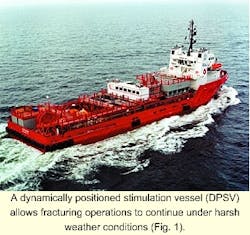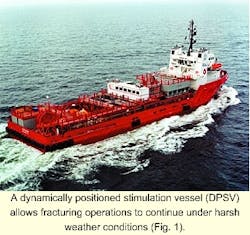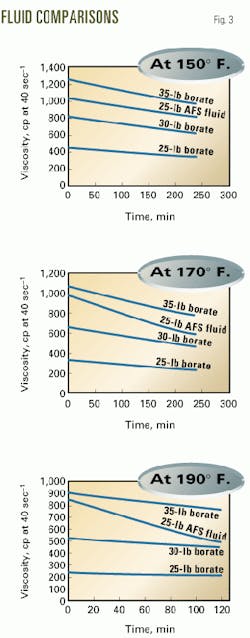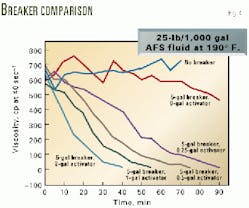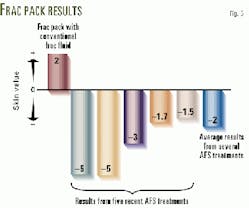Two frac-pack jobs set new treatment size records in the Gulf of Mexico according to Halliburton Energy Services Inc.
The jobs, pumped from a dynamically positioned stimulation vessel (DPSV), included an advanced frac-pack system (AFS) that consists of a low-guar, borate-crosslinked fracturing fluid mixed from seawater and gel.
Halliburton says in the first job, the fracturing crew pumped a frac-pack job with a low-polymer fluid. Seawater was used as the base for the fracturing fluid, and the system was applied on the fly. The job placed about 100,000 lb of proppant at 35 bbl/min.
For the second job, which broke the record established during the first job, the crew placed about 160,000 lb of proppant at 40 bbl/min.
Halliburton says in previous frac-pack attempts in which a third-party service company used conventional systems, operations failed before the minifrac and acid-injection phases were completed. In those attempts, pump rates reached only 31 bbl/min with treating pressures exceeding 9,200 psi. Those attempts also included fracturing fluids crosslinked at surface that resulted in higher surface pressures.
Treating vessel
Halliburton describes the DPSV (Figs. 1 and 2) as being designed to perform high-rate water packs, frac-pack operations, carbon dioxide and nitrogen treatments, acidizing, and resin-consolidation operations. The vessel's features are as follows:
- Pumps capable of 15,000-psi working pressure.
- 50 bbl/min mini-blender.
- Above-deck proppant capacity of more than 650,000 lb.
- A 400-ft, reel-mounted, 3-in., high-pressure hose capable of accommodating an additional reel.
- Remote, hydraulic quick-disconnect.
- Automatic remote controls for all operational procedures.
- Process fluid pump redundancy
In addition, the vessel is equipped with a dynamic positioning (DP) system, which includes antiroll tanks and a computerized ballast-control system. DP vessels are capable of responding to drastically changing weather conditions. The DP system interprets environmental data and allows the operator to hold or change the vessel's position accordingly.
Consequently, Halliburton says, the DPSV can remain steady and in close proximity to deepwater rigs in swells as high as 15 ft.
Frac-pack design
Frac-pack treatments involve creating a large fracture beyond the near-wellbore region. This fracture bypasses the damaged, restrictive area of the formation, expanding the effective wellbore radius. The enlarged wellbore radius helps increase flow rates and decrease drawdown, which is the difference between flowing and reservoir pressure.
Drawdown initiates hydrocarbon flow into the wellbore, but it can also destabilize the formation, causing fines and formation sand to migrate into the wellbore where they cluster, impairing conductivity and decreasing production.1
In addition to increasing flow rates and decreasing drawdown, frac-pack treatments help operators achieve better sand control, full zonal coverage in highly laminated reservoirs and nonperforated zones, and greater control of non-Darcy flow effects.
Halliburton's advanced frac-pack system (AFS) consists of a borate-crosslinked fracturing fluid with low guar content. It says in recent years, borate-crosslinked fracturing fluids have become increasingly popular for the following reasons:
- Provide excellent viscosity (Fig. 3).1 2
- Reheal with minimal deterioration under shear conditions because the crosslinks continually break and reform.
- Contain inexpensive and naturally occurring borate salts.
Halliburton says its AFS fluid is different from conventional fluids because it requires 20-25% less polymer loading. Consequently, potential formation damage from gel residue and filter-cake buildup is reduced. In addition, low-polymer gels can be broken more easily, facilitating faster, easier cleanup.
The new fluid formulation is environmentally acceptable in the Gulf of Mexico and offers the advantage of offshore disposal without environmental risks, thereby reducing disposal costs, according to Halliburton.
Seawater
In offshore operations, seawater is a cost-effective base for fracturing fluids because it is plentiful and readily available. With freshwater, the vessel must return to a base where it is reloaded. The time required for refilling fracturing-fluid tanks with freshwater can be as long as 12 hr.
By substituting seawater for freshwater in offshore jobs, operators can significantly reduce their overall completion costs.1
Halliburton says in the past, operators were reluctant to use seawater with fracturing fluids because of the potential problems associated with fluid incompatibility and the precipitation of magnesium salts. Halliburton, however, has adjusted the AFS fluid to overcome these problems, making it suitable for both freshwater and seawater applications.1
Breakers
Halliburton includes a specifically designed breaker in the AFS fluid. It says, while conventional breakers are only effective at temperatures up to 170° F., the AFS breaker was designed for temperatures above 150° F.1 2
The new breaker exhibits an initial delay followed by a rapid break, allowing operators to maximize breaker loading without changing the rheological properties of the fracturing fluids during the treatment. Halliburton has also designed the breaker to provides adjustable break times, allowing it to be tailored to individual treatment needs.
Fluid loss
Halliburton says the AFS fluid-loss control is as effective as conventional borate systems. In tests performed on 200-md Berea cores at 140° F., a 25 lb/1,000 gal fluid exhibited a spurt loss of 0.23 gal/sq ft and a fluid-loss coefficient (Cw) of 0.0030 ft/min1/2.
This compares to a conventional 35 lb/1,000 gal fluid that exhibits a spurt loss of 0.63 gal/sq ft and a 0.0035 ft/min1/2 Cw.3
Conductivity
Long-term production is directly related to fracture conductivity, which is dependent on the fracturing fluid. Excessive gel and other insoluble residues can significantly reduce fracture conductivity.
Halliburton says because the AFS places less gel in the formation, it also leaves less gel behind, when compared to conventional borate-crosslinked fracturing fluids. AFS fluids allow 30-40% more fracture conductivity to be retained.1
Proppant transport
Halliburton's tests have shown that both conventional borate-crosslinked fracturing fluids and AFS fracturing fluids exhibit good dynamic proppant-transport capabilities. AFS fluids, however, exhibit near-perfect laminar-flow profiles, while conventional borate fluids create distinct layers of proppant-laden fluid traveling at different velocities and having different apparent viscosities.
In addition, the fluids distribute proppant homogeneously throughout the height of the fracture simulator while the conventional fluids show signs of stratification.
The conventional fluid also deposits high concentrations of proppant at the bottom of the simulator.1 2
Skin
The success of a stimulation treatment is indicated by the skin factor. Positive skin indicates formation damage or impaired productivity.
Halliburton indicates the AFS fluid typically produces low skin values and often produces negative skins, indicating a successful stimulation treatment.1
Fig. 7 compares the skins from conventional fracturing fluids and the AFS fluid.
Control
In addition to providing adjustable break times, Halliburton says the AFS allows gel to be mixed on the fly. Consequently, each treatment can be tailored to meet the needs of the operator.
The system's on-the-fly capabilities enable instantaneous gel loading and base-gel viscosity changes with no time lapse.
References
- Ali, Syed A., et al., "Offshore frac packs benefit from seawater-based borate fluid," OGJ, Vol. 96, No. 39, Sept. 28, 1998, pp. 49-62.
- Powell, R.J., et al., "Gulf of Mexico Frac-and-Pack Treatments Using a New Fracturing Fluid System," Paper No. SPE 39897, International Petroleum Conference and Exhibition of Mexico, Mar. 3-5, 1998.
- Terracina, J.M., Yaritz, J.G., Powell, R.J., McCabe, M.A., Slabaugh, B.F., and McKeon, M.J., "Low Gel Loading Increases Well Production in Eastern U.S.," Paper No. SPE 51070 SPE Eastern Regional Conference and Exhibition, Pittsburgh, Nov. 9-10, 1998.
